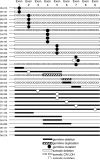Spectrum of SMARCB1/INI1 mutations in familial and sporadic rhabdoid tumors
- PMID: 21108436
- PMCID: PMC3086793
- DOI: 10.1002/pbc.22831
Spectrum of SMARCB1/INI1 mutations in familial and sporadic rhabdoid tumors
Abstract
Background: Germline mutations and deletions of SMARCB1/INI1 in chromosome band 22q11.2 predispose patients to rhabdoid tumor and schwannomatosis. Previous estimates suggested that 15-20% of rhabdoid tumors were caused by an underlying germline abnormality of SMARCB1. However, these studies were limited by case selection and an inability to detect intragenic deletions and duplications.
Procedure: One hundred matched tumor and blood samples from patients with rhabdoid tumors of the brain, kidney, or soft tissues were analyzed for mutations and deletions of SMARCB1 by FISH, multiplex ligation-dependent probe amplification (MLPA), sequence analysis and high resolution Illumina 610K SNP-based oligonucleotide array studies.
Results: Thirty-five of 100 patients were found to have a germline SMARCB1 abnormality. These abnormalities included point and frameshift mutations, intragenic deletions and duplications, and larger deletions including regions both proximal and distal to SMARCB1. There were nine cases that demonstrated parent to child transmission of a mutated copy of SMARCB1. In eight of the nine cases, one or more family members were also diagnosed with rhabdoid tumor or schwannoma, and two of the eight families presented with multiple affected children in a manner consistent with gonadal mosaicism.
Conclusions: Approximately one-third of newly diagnosed patients with rhabdoid tumor have an underlying genetic predisposition to tumors due to a germline SMARCB1 alteration. Families may demonstrate incomplete penetrance and gonadal mosaicism, which must be considered when counseling families of patients with rhabdoid tumor.
Figures



Comment in
-
Malignant rhabdoid tumors: a familial condition?Pediatr Blood Cancer. 2011 Jan;56(1):1-2. doi: 10.1002/pbc.22834. Pediatr Blood Cancer. 2011. PMID: 21108435 Review. No abstract available.
Similar articles
-
High-density single nucleotide polymorphism array analysis in patients with germline deletions of 22q11.2 and malignant rhabdoid tumor.Hum Genet. 2007 Sep;122(2):117-27. doi: 10.1007/s00439-007-0386-3. Epub 2007 May 31. Hum Genet. 2007. PMID: 17541642
-
Rhabdoid tumor predisposition syndrome caused by SMARCB1 constitutional deletion: prenatal detection of new case of recurrence in siblings due to gonadal mosaicism.Fam Cancer. 2016 Jan;15(1):123-6. doi: 10.1007/s10689-015-9836-6. Fam Cancer. 2016. PMID: 26342593
-
High-resolution genomic analysis suggests the absence of recurrent genomic alterations other than SMARCB1 aberrations in atypical teratoid/rhabdoid tumors.Genes Chromosomes Cancer. 2013 Feb;52(2):185-90. doi: 10.1002/gcc.22018. Epub 2012 Oct 17. Genes Chromosomes Cancer. 2013. PMID: 23074045
-
Biology and Treatment of Rhabdoid Tumor.Crit Rev Oncog. 2015;20(3-4):199-216. doi: 10.1615/critrevoncog.2015013566. Crit Rev Oncog. 2015. PMID: 26349416 Free PMC article. Review.
-
Pathology and diagnosis of SMARCB1-deficient tumors.Cancer Genet. 2014 Sep;207(9):358-64. doi: 10.1016/j.cancergen.2014.07.004. Epub 2014 Aug 1. Cancer Genet. 2014. PMID: 25246033 Review.
Cited by
-
Molecular Markers of Pediatric Solid Tumors-Diagnosis, Optimizing Treatments, and Determining Susceptibility: Current State and Future Directions.Cells. 2022 Apr 6;11(7):1238. doi: 10.3390/cells11071238. Cells. 2022. PMID: 35406801 Free PMC article. Review.
-
The identification of miRNA and mRNA expression profiles associated with pediatric atypical teratoid/rhabdoid tumor.BMC Cancer. 2022 May 6;22(1):499. doi: 10.1186/s12885-022-09549-6. BMC Cancer. 2022. PMID: 35524230 Free PMC article.
-
Co-occurrence of schwannomatosis and rhabdoid tumor predisposition syndrome 1.Mol Genet Genomic Med. 2018 May 20;6(4):627-37. doi: 10.1002/mgg3.412. Online ahead of print. Mol Genet Genomic Med. 2018. PMID: 29779243 Free PMC article.
-
Malignant rhabdoid tumor of the small intestine in adults: a brief review of the literature and report of a case.Surg Today. 2015 Jul;45(7):924-8. doi: 10.1007/s00595-014-0955-8. Epub 2014 Jun 25. Surg Today. 2015. PMID: 24957511 Review.
-
Intracranial cystic lesions: a review.Curr Neurol Neurosci Rep. 2014 Sep;14(9):481. doi: 10.1007/s11910-014-0481-5. Curr Neurol Neurosci Rep. 2014. PMID: 25106500 Review.
References
-
- Versteege I, Sévenet N, Lange J, et al. Truncating mutations of hSNF5/INI1 in aggressive paediatric cancer. Nature. 1998;394:203–206. - PubMed
-
- Biegel JA, Zhou J, Rorke LB, et al. Germ-line and acquired mutations of INI1 in atypical teratoid rhabdoid tumors. Cancer Res. 1999;59:74–79. - PubMed
-
- Reisman D, Glaros S, Thompson EA. The SWI/SNF complex and cancer. Oncogene. 2009;28:1653–1668. - PubMed
-
- Hornick JL, Dal Cin P, Fletcher CDM. Loss of INI1 expression is characteristic of both conventional and proximal-type epithelioid sarcoma. Am J Surg Pathol. 2009;33:542–550. - PubMed
Publication types
MeSH terms
Substances
Grants and funding
LinkOut - more resources
Full Text Sources
Other Literature Sources
Medical

